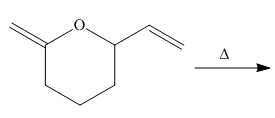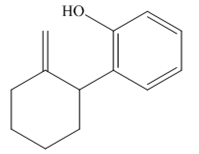
Concept explainers
Draw the products of each reaction.
a. c.
c. 
b. d.
d. 
(a)
Interpretation: The product formed for the given reaction is to be drawn.
Concept introduction: Curved arrows aid in determining the movement and flow of electrons in the reaction. The electrons that take part in the chemical reactions are shown by the curved arrows.
In the sigmatropic rearrangement, the rearrangement of pi bond and the breaking of sigma bond take place. This results in the generation of new sigma bond in the product. In this type of rearrangement, the number of pi bonds remains constant in the reactant as well as in the product.
Answer to Problem 27.50P
The product formed for the given reaction is

Explanation of Solution
The given reaction is shown below.

Figure 1
The product formed for the given reaction is shown below.

Figure 2
In the given reaction, curved arrows shows the movement of pi bonds to give the final product. In this type of reaction, the compound undergoes to the
Thus, the name of product formed is
The product formed for the given reaction is
(b)
Interpretation: The product formed for the given reaction is to be drawn.
Concept introduction: Curved arrows aid in determining the movement and flow of electrons in the reaction. The electrons that take part in the chemical reactions are shown by the curved arrows.
In the sigmatropic rearrangement, the rearrangement of pi bond and the breaking of sigma bond take place. This results in the generation of new sigma bond in the product. In this type of rearrangement, the number of pi bonds remains constant in the reactant as well as in the product.
Answer to Problem 27.50P
The product formed for the given reaction is

Explanation of Solution
The given reaction is shown below.

Figure 3
The product formed for the given reaction is shown below.

Figure 4
The first step in the given reaction is the formation of enolate ion. The curved arrows show the movement of pi bonds to give the final product. In the next step, the compound undergoes to the
Thus, the product formed for the given reaction is
The product formed for the given reaction is
(c)
Interpretation: The product formed for the given reaction is to be drawn.
Concept introduction: Curved arrows aid in determining the movement and flow of electrons in the reaction. The electrons that take part in the chemical reactions are shown by the curved arrows.
In the sigmatropic rearrangement, the rearrangement of pi bond and the breaking of sigma bond take place. This results in the generation of new sigma bond in the product. In this type of rearrangement, the number of pi bonds remains constant in the reactant as well as in the product.
Answer to Problem 27.50P
The product formed for the given reaction is

Explanation of Solution
The given reaction is shown below.

Figure 5
The product formed for the given reaction is shown below.

Figure 6
In the given reaction, curved arrows shows the movement of pi bonds to give the final product. In this type of reaction, the compound undergoes to the
Thus, the name of product formed is
The product formed for the given reaction is
(d)
Interpretation: The product formed for the given reaction is to be drawn.
Concept introduction:
Answer to Problem 27.50P
The product formed for the given reaction is,

Explanation of Solution
The given reaction is shown below.

Figure 7
The molecular formula of the product is
The product formed for the given reaction is shown below.

Figure 8
The given reactant undergoes
The product formed for the given reaction is shown in Figure 8.
Want to see more full solutions like this?
Chapter 27 Solutions
Organic Chemistry-Package(Custom)
- Would the following organic synthesis occur in one step? Add any missing products, required catalysts, inorganic reagents, and other important conditions. Please include a detailed explanation and drawings showing how the reaction may occur in one step.arrow_forward(a) Sketch the 'H NMR of the following chemical including the approximate chemical shifts, the multiplicity (splitting) of all signals and the integration (b) How many signals would you expect in the 13C NMR? CH3arrow_forwardDraw the Show the major and minor product(s) for the following reaction mechanisms for both reactions and show all resonance structures for any Explain why the major product is favoured? intermediates H-Brarrow_forward
- 3. Draw ALL THE POSSBILE PRODUCTS AND THE MECHANISMS WITH ALL RESONANCE STRUCTURES. Explain using the resonance structures why the major product(s) are formed over the minor product(s). H₂SO4, HONO CHarrow_forward7. Provide the product(s), starting material(s) and/or condition(s) required for the No mechanisms required. below reaction HO + H-I CI FO Br2, FeBr3 O I-Oarrow_forward6. Design the most efficient synthesis of the following product starting from phenot Provide the reaction conditions for each step (more than one step is required) and explain the selectivity of each reaction. NO MECHANISMS ARE REQUIRED. OH step(s) CIarrow_forward
- What is the skeletal structure of the product of the following organic reaction?arrow_forwardIf a reaction occurs, what would be the major products? Please include a detailed explanation as well as a drawing showing how the reaction occurs and what the final product is.arrow_forwardWhat is the major organic product of the following nucleophilic acyl substitution reaction of an acid chloride below?arrow_forward
 ChemistryChemistryISBN:9781305957404Author:Steven S. Zumdahl, Susan A. Zumdahl, Donald J. DeCostePublisher:Cengage Learning
ChemistryChemistryISBN:9781305957404Author:Steven S. Zumdahl, Susan A. Zumdahl, Donald J. DeCostePublisher:Cengage Learning ChemistryChemistryISBN:9781259911156Author:Raymond Chang Dr., Jason Overby ProfessorPublisher:McGraw-Hill Education
ChemistryChemistryISBN:9781259911156Author:Raymond Chang Dr., Jason Overby ProfessorPublisher:McGraw-Hill Education Principles of Instrumental AnalysisChemistryISBN:9781305577213Author:Douglas A. Skoog, F. James Holler, Stanley R. CrouchPublisher:Cengage Learning
Principles of Instrumental AnalysisChemistryISBN:9781305577213Author:Douglas A. Skoog, F. James Holler, Stanley R. CrouchPublisher:Cengage Learning Organic ChemistryChemistryISBN:9780078021558Author:Janice Gorzynski Smith Dr.Publisher:McGraw-Hill Education
Organic ChemistryChemistryISBN:9780078021558Author:Janice Gorzynski Smith Dr.Publisher:McGraw-Hill Education Chemistry: Principles and ReactionsChemistryISBN:9781305079373Author:William L. Masterton, Cecile N. HurleyPublisher:Cengage Learning
Chemistry: Principles and ReactionsChemistryISBN:9781305079373Author:William L. Masterton, Cecile N. HurleyPublisher:Cengage Learning Elementary Principles of Chemical Processes, Bind...ChemistryISBN:9781118431221Author:Richard M. Felder, Ronald W. Rousseau, Lisa G. BullardPublisher:WILEY
Elementary Principles of Chemical Processes, Bind...ChemistryISBN:9781118431221Author:Richard M. Felder, Ronald W. Rousseau, Lisa G. BullardPublisher:WILEY





